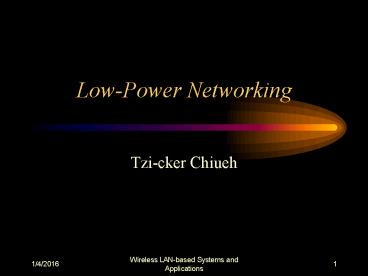Low-Power Networking - PowerPoint PPT Presentation
1 / 8
Title:
Low-Power Networking
Description:
Goals Cutting down the power consumption of wireless network interfaces Slow down ... (ad hoc) network Provisions in 802.11 Power Saving Mode ... IEEE 802.11 Standard ... – PowerPoint PPT presentation
Number of Views:63
Avg rating:3.0/5.0
Title: Low-Power Networking
1
Low-Power Networking
- Tzi-cker Chiueh
2
Goals
- Cutting down the power consumption of wireless
network interfaces - Slow down the clock
- Go to sleep if there is nothing to do
- First question is this really important?
- Power-aware routing Maximize the lifetime of an
(ad hoc) network
3
Provisions in 802.11
- Power Saving Mode
- Client notifies AP when it enters PSM (with a
ListenInterval specification) - Clients wake up periodically to listen to beacon
- Beacon contains traffic indication map to tell
which node has packets buffered on AP - Client explicitly asks AP to forward buffered
packets
4
Problems with PSM
- TCP unfriendly increase in round-trip delay
(rounded up to bean period, 100 msec) causes
throughput to drop - Periodic wake-up costs power for nothing because
idle period is longer than 100msec - Optimizations
- Stay-Awake (0.1sec)
- ListenInterval-Backoff (2x up to 0.9 sec)
- Max-Delay never sleeps more than 20 of the last
activity interval
5
Better Optimizations
- TCP-directed sleep interval determination
- Based on round-trip delay measurements of active
connections - Based on the fact that there are no pending
packets - Apply to only wireless stations that serve as
pure Internet clients with NRT traffic
6
More Optimization Ideas
- Apply the idea of I-TCP for client-side power
optimization - Explicitly tell each MN when to wake up
- Proxy estimate the round-trip delay of Web page
response time, including caching effects - Buffer downstream data and avoid trigger
congestion control at the remote sender - Coordinate MNs wakeup time and channel access
- Support prefetching to compensate batching delay
at the client for upstream traffic
7
Streaming Downstream Traffic
- Relatively easy to deal with buffer and batching
- Should work in a way that is independent of media
streams - Transcoding if necessary
8
Synergy between QoS and LPN
- QoS is about transmission slot allocation
- Low-power networking is about when interface
should be up to receive packets - How to integrate the two?
- Tradeoff in latency increase and power reduction
- What can the infrastructure do more to reduce the
power consumption at the clients - High-gain antenna
- Prefetching
- Computation































